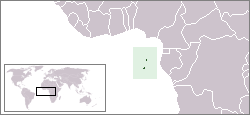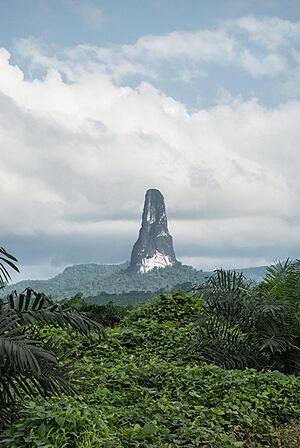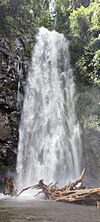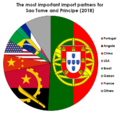São Tomé and Príncipe facts for kids
Quick facts for kids
Democratic Republic of São Tomé and Príncipe
República Democrática de São Tomé e Príncipe (Portuguese)
|
|
|---|---|
|
|
|
|
Motto: "Unidade, Disciplina, Trabalho"
("Unity, Discipline, Labour") |
|
|
Anthem: "Independência total"
("Total Independence") |
|
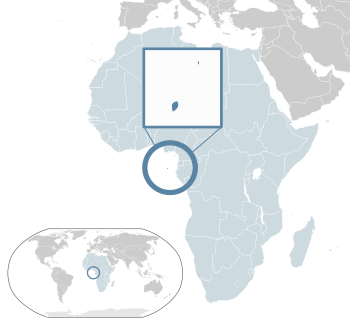
Location of São Tomé and Príncipe (dark blue)
in Africa (light blue) |
|
| Capital and largest city
|
São Tomé 0°20′N 6°44′E / 0.333°N 6.733°E |
| Official languages | Portuguese |
| Recognised regional languages |
|
| Religion
(2020)
|
|
| Demonym(s) |
|
| Government | Unitary semi-presidential republic |
| Carlos Vila Nova | |
| Américo Ramos | |
| Legislature | National Assembly |
| Independence | |
|
• from Portugal
|
12 July 1975 |
| Area | |
|
• Total
|
964 km2 (372 sq mi) (171st) |
|
• Water (%)
|
Negligible |
| Population | |
|
• 2023 estimate
|
220,372 (175th) |
|
• Density
|
199.7/km2 (517.2/sq mi) (69th) |
| GDP (PPP) | 2024 estimate |
|
• Total
|
|
|
• Per capita
|
|
| GDP (nominal) | 2024 estimate |
|
• Total
|
|
|
• Per capita
|
|
| Gini (2017) | ▲ 56.3 high |
| HDI (2022) | medium · 141st |
| Currency | Dobra (STN) |
| Time zone | UTC (GMT) |
| Date format | dd/mm/yyyy |
| Driving side | right |
| Calling code | +239 |
| ISO 3166 code | ST |
| Internet TLD | .st |
The Democratic Republic of São Tomé and Príncipe is the second smallest African country, formed by two islands: São Tomé and Príncipe.
They are about 140 km apart and about 250 and 225 km, respectively, off of the northwestern coast of Gabon.
The islands were a Portuguese colony, but have been independent since July,1975. Portuguese is the official language.
Contents
History
The islands were uninhabited until their discovery in 1470 by Portuguese explorers João de Santarém and Pedro Escobar. Gradually colonized and settled throughout the 16th century, they collectively served as a vital commercial and trade centre for the Atlantic slave trade. The rich volcanic soil and proximity to the equator made São Tomé and Príncipe ideal for sugar cultivation, followed later by cash crops such as coffee and cocoa; the lucrative plantation economy was heavily dependent upon enslaved Africans.
On February 3, 1953 the Massacre of Batepá occurred, when thousands of local people were killed by Portuguese settlers as a consequence of a disagreement between them about hired labour. Since slavery had been abolished, the Portuguese needed workers for their cacao and coffee plantations and the local people refused to work under the conditions offered, which, for them, were similar to slavery.
The archipelago’s independence movement started with the constitution of the CLSTP (Committee for the Liberation of São Tomé and Principe), formed in the late 1950s, which changed its name to MLSTP (Movement for the Liberation of São Tomé and Príncipe), the first political party after the independence, on July 12, 1975.
Politics
When São Tomé and Príncipe was declared independent and became the Democratic Republic of São Tomé and Príncipe, Manuel Pinto da Costa, the MLSTP`s General Secretary, was named the first archipelago president. From then on, the political system implemented was the single party regime which prevailed until the 1990s when there was a political and economic reform and the multiparty regime was implemented. In the first presidential election, Miguel Trovoada was elected as the second president of the islands. His successor, after two terms, was Fradique de Menezes, the current president who is in his second presidential term.
The president, like the prime minister, is elected by direct universal suffrage for a five-year term and can be re-elected. The PM is elected for a four-year term, and the thirteen members of the cabinet (the group of ministers) are chosen by him.
The cabinet constitutes the executive power and shares the legislative power with the National Assembly. The judiciary is independent from the other two.
As a multiparty regime, the country’s main political parties are: the Movement for the Liberation of São Tomé and Príncipe (MLSTP), the Party of Democratic Convergence (PCD), the Independent Democratic Action (ADI), and the Democratic Movement Force for Change - Liberal Party(MDFM-PL).
Provinces
São Tomé and Príncipe is divided into 2 provinces: Príncipe, São Tomé.
The provinces are further divided into seven districts, six on São Tomé and one on Príncipe (with Príncipe having self-government since April 29, 1995).
Cities
| Cities in São Tomé und Príncipe | |||||
| Rank | Place | Population | District | ||
| Census 1991 | Census 2001 | Estimate 2005 | |||
| 1. | São Tomé (capital) | 42,331 | 49,957 | 56,166 | Água Grande |
| 2. | Santo Amaro | 5,878 | - | 8,239 | Lobata |
| 3. | Neves | 5,919 | 6,635 | 7,392 | Lembá |
| 4. | Santana | 6,190 | 6,228 | 6,969 | Cantagalo |
| 5. | Trindade | - | 6,049 | 6,636 | Mé-Zóchi |
| 6. | Santa Cruz | - | 1,862 | 2,045 | Caué |
| 7. | Pantufo | - | 1,929 | 2,169 | Água Grande |
| 8. | Guadalupe | - | 1,543 | 1,734 | Lobata |
| 9. | Santo António | 1,000 | 1,010 | 1,156 | Pagué |
| 10. | Santa Catarina | - | - | 971 | Lembá |
| 11. | Porto Alegre | - | - | 334 | Caué |
Geography
The two islands that make up what is called São Tomé and Príncipe were formed 30 million years ago during the Oligocene era, due to volcanic activity beneath deep water along the Cameroon Line. The volcanic soils of basalts and phonolites, dating to 3 million years, have been used for plantation crops since colonial times.
The islands of São Tomé and Príncipe, situated in the equatorial Atlantic and Gulf of Guinea about 300 and 250 km (190 and 160 mi), respectively, off the northwest coast of Gabon, constitute Africa's second-smallest country. Both are part of the Cameroon volcanic mountain line, which also includes the islands of Annobón to the southwest, Bioko to the northeast (both part of Equatorial Guinea), and Mount Cameroon on the coast of Gulf of Guinea. São Tomé is 50 km (30 mi) long and 30 km (20 mi) wide and the more mountainous of the two islands. Its peaks reach 2,024 m (6,640 ft) – Pico de São Tomé. Príncipe is about 30 km (20 mi) long and 6 km (4 mi) wide. Its peaks reach 948 m (3,110 ft) – Pico de Príncipe. Swift streams radiating down the mountains through lush forest and cropland to the sea cross both islands. The Equator lies immediately south of São Tomé Island, passing through the islet Ilhéu das Rolas.
The Pico Cão Grande (Great Dog Peak) is a landmark volcanic plug peak, at 0°7′0″N 6°34′00″E / 0.11667°N 6.56667°E in southern São Tomé. It rises over 300 m (1,000 ft) above the surrounding terrain and the summit is 663 m (2,175 ft) above sea level.
Climate
The climate of São Tomé and Príncipe is essentially conditioned by its geographic location, subject to the seasonal translation of low equatorial pressures, the monsoon winds from the south, the warm Guinea Current and the relief.
At sea level, the climate is tropical—hot and humid with average yearly temperatures of about 26 °C (78.8 °F) and little daily variation. The temperature rarely rises beyond 32 °C (89.6 °F). At the interior's higher elevations, the average yearly temperature is 20 °C (68 °F), and nights are generally cool. Annual rainfall varies from 7,000 mm (275.6 in) in the highland cloud forests to 800 mm (31.5 in) in the northern lowlands. The rainy season is from October to May.
Biodiversity
The country's territory is part of the São Tomé, Príncipe, and Annobón moist lowland forests ecoregion. It had a 2019 Forest Landscape Integrity Index mean score of 6.64/10, ranking it 68th globally out of 172 countries. São Tomé and Príncipe does not have a large number of native mammals (although the São Tomé shrew and several bat species are endemic). The islands are home to a larger number of endemic birds and plants, including the world's smallest ibis (the São Tomé ibis), the world's largest sunbird (the giant sunbird), the rare São Tomé fiscal, and several giant species of Begonia. São Tomé and Príncipe is an important marine turtle-nesting site, including the hawksbill turtles (Eretmochelys imbricata).
Politics
The president of the republic is elected to a five-year term by direct universal suffrage and a secret ballot, and must gain an outright majority to be elected. The president may hold up to two consecutive terms. The prime minister is appointed by the president, and the 14 members of the cabinet are chosen by the prime minister.
The National Assembly, the supreme organ of the state and the highest legislative body, is made up of 55 members, who are elected for a four-year term and meet semiannually. Justice is administered at the highest level by the Supreme Court. The judiciary is independent under the current constitution.
Economy
Since the archipelago´s discovery, its economy has been based on agriculture and fishing. Nowadays its main crop is cacao; it represents 95% of the country’s exports, and is followed by copper, palm oil and coffee. Another economic activity is tourism, which the government and the private sector have been trying to promote and develop in the last few years.
After independence, the country’s economy was nationalized until the early 1990s when the government started an economic reform that consisted in privatization of the economic sectors.
Nowadays, the government budget is mainly based on foreign assistance from donors such as the UN Development Programme, the World Bank, and country donors.
The main importers of the archipelago's production are Portugal with 51%, France with 14%, Angola with 11%, and Japan with 10%.
In 2001, petroleum was found in the waters claimed by the archipelago and Nigeria. After negotiations, the two countries reached an agreement and, in 2003, a joint development zone was opened for bids. But so far, there is no petroleum exploitation yet.
Demographics
The total population was estimated at 201,800 in May 2018 by the government agency. About 193,380 people live on São Tomé and 8,420 on Príncipe. The natural population increase is about 4,000 people per year.
Nearly all citizens are descended from people from different countries taken to the islands by the Portuguese from 1470 onwards. In the 1970s, two significant population movements occurred — the exodus of most of the 4,000 Portuguese residents and the influx of several hundred São Tomé refugees from Angola.
Distinct ethnic groups on São Tomé and Príncipe include:
- Luso-Africans, or "mixed-blood", are descendants of Portuguese colonists and African slaves brought to the islands during the early years of settlement from Benin, Gabon, the Republic of the Congo, the Democratic Republic of the Congo, and Angola (these people also are known as filhos da terra or "children of the land").
- Angolares are reputedly descendants of Angolan slaves who survived a 1540 shipwreck and now earn their livelihood fishing.
- Forros are descendants of freed slaves when slavery was abolished.
- Serviçais are contract laborers from Angola, Mozambique, and Cape Verde, living temporarily on the islands.
- Tongas are children of serviçais born on the islands.
- Europeans, primarily Portuguese
- Asians, mostly Chinese, including Macanese people of mixed Portuguese and Chinese descent from Macau
The majority of residents belong to the local branch of the Roman Catholic Church, which in turn retains close ties with the church in Portugal.
Languages
Portuguese is the official and the de facto national language of São Tomé and Príncipe, with about 98.4% speaking it, a significant share as their native language, and it has been spoken in the islands since the end of the 15th century.French (6.8%) and English (4.9%) are foreign languages taught in schools.
Culture
The country’s culture is the product of Portuguese and African cultural influence. Typical dances on the islands are: Ússua, Socopé, Dêxa, and Puita. Tchiloli, Danço Congo and Auto dos Floripes are public theatrical performances, examples of the Portuguese cultural legacy.
Important names of the archipelago history and culture are King Amador and Alda Espírito Santos (1926-2010).
Cuisine
Staple foods include fish, seafood, beans, maize, bread fruit, and cooked banana. Tropical fruits, such as pineapple, avocado, and bananas, are significant components of the cuisine. The use of hot spices is prominent in São Tomése cuisine. Coffee is used in various dishes as a spice or seasoning. Breakfast dishes are often reheated leftovers from the previous evening's meal, and omelettes are popular.
Images for kids
-
Capture of São Tomé by Cornelis Jol of the Dutch West India Company in 1641.
-
The Our Lady of Grace Cathedral of São Tomé
See also
 In Spanish: Santo Tomé y Príncipe para niños
In Spanish: Santo Tomé y Príncipe para niños




